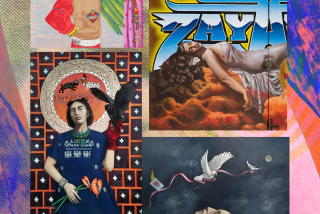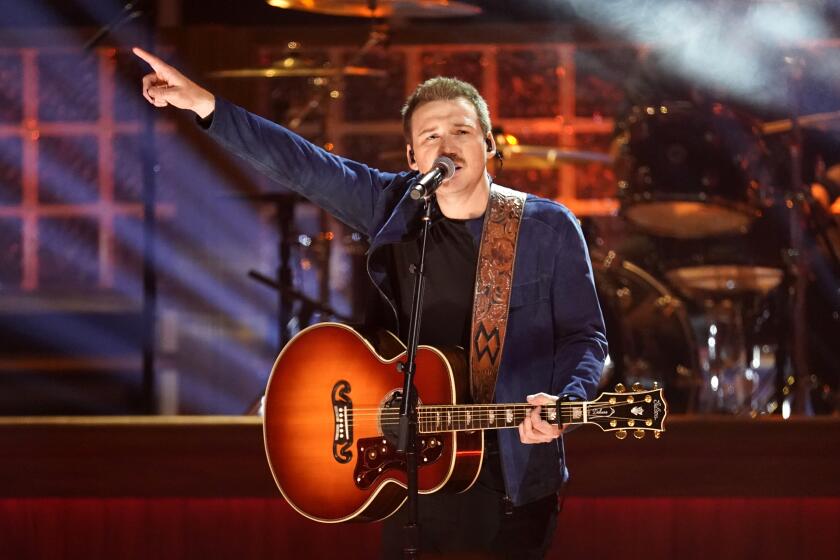‘Pacific Standard Time’: Exhibitions to keep an eye on
A few of the 60-plus shows have already opened, but “Pacific Standard Time: Art in L.A. 1945-1980” officially gets launched Oct. 1 and 2 with a trio of major surveys opening at the Getty, MOCA and LACMA. Here’s an annotated list of some of the more intriguing exhibitions. Start your engines.
— Christopher Knight
CURRENTLY ON VIEW:
It Happened at Pomona: Art at the Edge of Los Angeles, 1969-1973; Part 1: Hal Glicksman, Pomona College Museum of Art
With no art museum infrastructure to speak of in postwar L.A., schools were critical venues for showing new art. Pomona College, where Jose Clemente Orozco had painted the first major Modern U.S. fresco in 1930, was unusually active. This is the first of a three-part show, focusing on the school’s ambitious curatorial programs, continuing into 2012.
Asco: Elite of the Obscure, A Retrospective, 1972-1987, LACMA
In the Mexican mural tradition, public walls “spoke” about public issues. The rambunctious Chicano collective Asco (Gronk, Patssi Valdez, Harry Gamboa Jr., Willie Herrón and Humberto Sandoval) went one better by occasionally taping its stylish members to urban walls. There they became part living-graffiti, part flailing image of Latino social marginalization and individual bondage.
Beatrice Wood: Career Woman — Drawings, Paintings, Vessels and Objects, Santa Monica Museum of Art
Beatrice Wood (1893-1998), rebellious daughter of wealthy San Francisco socialites, was dubbed the “Mama of Dada” for her close, life-long relationship to anti-artist Marcel Duchamp. A failed actress, minor artist and major studio potter (in Ojai), she aptly titled her 1985 autobiography “I Shock Myself.”
OPENING:
Sept. 25: Phenomenal: California Light, Space, Surface, Museum of Contemporary Art San Diego
Sometimes regarded as L.A.’s unique contribution to contemporary art in the ‘60s and ‘70s, Light & Space art focuses on the viewer’s bodily consciousness of perception. Works by Larry Bell, Mary Corse, Robert Irwin, Bruce Nauman, James Turrell and Doug Wheeler will be on view.
Sept. 28: Sympathetic Seeing: Esther McCoy and the Heart of American Modernist Architecture and Design, MAK Center at the Schindler House
Esther McCoy (1904-1989) was one of the 20th century’s greatest architecture critics and historians, a writer of insightful clarity and fierce social commitment no doubt honed by her work as a researcher for Theodore Dreiser and, later, as an architectural draftsman. Green & Green, Irving Gill, Bernard Maybeck, Rudolf Schindler and Richard Neutra were among the architects whose work she championed and illuminated.
Oct. 1: California Design, 1930-1965: ‘Living in a Modern Way,’ LACMA
Say “Midcentury Modern” and you’re saying L.A. design, as World War II technologies were put to peace-time use, often inflected by postwar optimism and fueled by the city’s phenomenal growth. (Its population more than doubled during the show’s time-frame.) Prediction: Many of the 350 objects will look up-to-the-minute.
Oct. 1: Speaking in Tongues: The Art of Wallace Berman and Robert Heinecken, Armory Center for the Arts, Pasadena
A potential sleeper, the show provocatively juxtaposes the mystically inclined camera-based imagery of the great Beat generation artist Wallace Berman (1926-1976) with the politically astute, mass-media-savvy photo collages of Robert Heinecken (1931-2006).
Oct. 1: Seismic Shift: Lewis Baltz, Joe Deal and California Landscape Photography, 1944-1984, California Museum of Photography, UC Riverside
How did we get from the popular romantic vistas made by Edward Weston, Ansel Adams and Minor White, all crashing coastlines and monumental mountain peaks, to the stark typologies of suburban anonymity, like tract homes and industrial parks? The shift had an international impact. Here’s one account of the transformation.
Oct. 1: Pacific Standard Time: Crosscurrents in L.A. Paintings and Sculpture, 1950-1970, J. Paul Getty Museum
Nine years in the making! Forty-seven artists! Seventy-nine paintings, sculptures and mixed-media works! A spine for the behemoth “PST” series, this is the Getty’s flagship exhibition of L.A.’s first generation of international-grade artists. The show is bound to be at least somewhat controversial, if only for who’s in and who’s not.
Oct. 2: Under the Big Black Sun: California Art 1974-1981, MOCA
With the presidential fall of Richard Nixon and rise of Ronald Reagan as its cheeky California brackets, the show examines a publicly placid but conceptually rich artistic period — the setup for the creative explosion of the 1980s. The blowout includes about 125 artists. Meanwhile, that titular “black sun” suggests a less-than-cheery interval.
Oct. 2: Now Dig This! Art and Black Los Angeles 1960-1980, Hammer Museum, UCLA
David Hammons, one of the most important American artists of the last 35 years, is also the most well-known of the show’s 35 African American painters and sculptors. The eye-opening surprise, however, might turn out to be the late assemblage master, Noah Purifoy (1918-2004).
Oct. 30: Best Kept Secret: UCI and the Development of Contemporary Art in Southern California, 1964-1971, Laguna Art Museum
UC Irvine was formally founded — literally in the middle of nowhere, just off the brand-spanking-new 405 freeway — in 1965. But in no time flat the Orange County school’s art department attracted an impressive roster of artists and critics and developed notable students, artistically comparable to UCLA or Yale today. The list includes Michael Asher, Chris Burden, Vija Celmins, John Coplans, Robert Irwin, John McCracken, Bruce Nauman, Barbara Rose, Alexis Smith, Frank Stella and more.
Nov. 13: Naked Hollywood: Weegee in Los Angeles, MOCA
The golden age of notorious New York crime and street photographer Weegee, born Arthur Fellig (1899-1968), is generally dated from before World War II. In 1947 he moved to L.A. to work in Hollywood, turning his camera on stars, strippers and studio back-lots. Usually dismissed as selling out — odd for a guy who previously toiled for the New York tabloids — this period of his work hasn’t been closely examined before now.
Nov. 17: 46 N. Los Robles: A History of the Pasadena Art Museum, Pacific Asia Museum
When curator Walter Hopps’ retrospective of French iconoclast Marcel Duchamp opened on Oct. 8, 1963, the little Pasadena Art Museum went from being a virtual unknown to a national trailblazer. The Pacific Asia Museum, housed in PAM’s old Chinese-inspired building, will chronicle its full history, from modest roots in 1945 to spectacular flameout in 1974.
Dec. 3: It Happened at Pomona: Art at the Edge of Los Angeles, 1969-1973, Part 2: Helene Winer at Pomona, Pomona College Museum of Art
Hal Glicksman, examined in Part 1, went from Pasadena Art Museum exhibition designer to adventurous curator, specializing in Light and Space art. Afterward Helene Winer, now co-owner of New York’s prominent Metro Pictures gallery, continued the escapade with a focus on post-Minimalism and Conceptual art.
christopher.knight@latimes.com
More to Read
The biggest entertainment stories
Get our big stories about Hollywood, film, television, music, arts, culture and more right in your inbox as soon as they publish.
You may occasionally receive promotional content from the Los Angeles Times.







